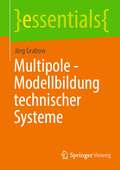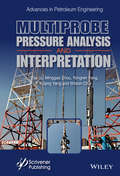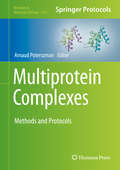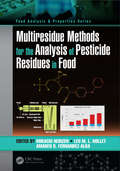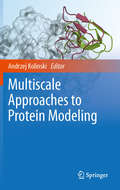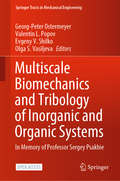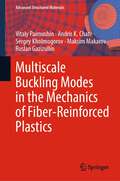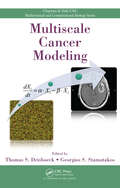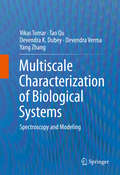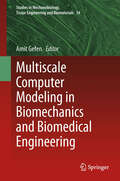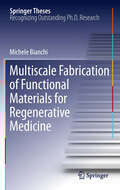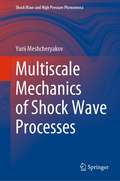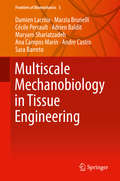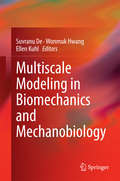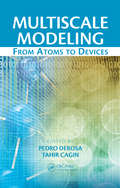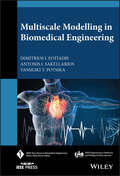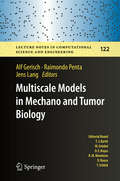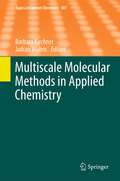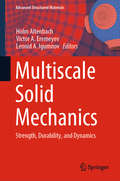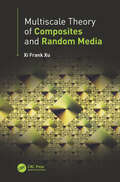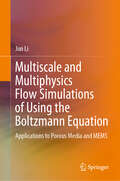- Table View
- List View
Multipole - Modellbildung technischer Systeme (essentials)
by Jörg GrabowDas vorliegende essential beschreibt einen allgemeingültigen, strukturierten Modellbildungsprozess für technische Systeme (Mechatronische Systeme) auf Basis von Multipolen. Die Verschiedenheit physikalisch-technischer Teilsysteme macht zunächst unterschiedliche Ordnungskriterien physikalischer Grundgrößen notwendig. Auf Grundlage dieser Ordnungskriterien werden anschließend allgemeingültige, physikalische Basisgrößen eingeführt, welche im Weiteren zu unabhängigen Teilsystemen erweitert werden. Abschließend erfolgt eine Verkopplung der unabhängigen Teilsysteme in Form von Multipolen über die Methoden der Netzwerkanalyse. Kurze Beispiele zu den jeweiligen Teilkomplexen ergänzen die theoretischen Ausführungen an geeigneter Stelle.
Multiprobe Pressure Analysis and Interpretation (Advances in Petroleum Engineering)
by Wilson ChinA popular 1990s formation tester with a single "pumping" probe and one passive "observation port" displaced 180 deg away, designed to measure pressures at two locations for permeability prediction, encounters well known detection problems at low mobilities. This book, using aerodynamics methods, explains why and also reveals the existence of a wide stagnation zone that hides critical formation details. And it does much more. An exact analytical solution is used to validate a new transient, three-dimensional, finite difference model for more general testers, one that guides new hardware designs with independent azimuthally displaced probes having with different rates, flow schedules and nozzle geometries, supports interpretation and formation evaluation, and assists with job planning at the rigsite. The methods also apply to conventional tools, allowing comparisons between older and newer technologies. Importantly, the authors introduce a completely new three-probe design with independently operable active elements that eliminate all older tool deficiencies. Numerous subjects are discussed, such as pressure transient analyses with multiple operating probes, supercharge analysis with invasion and mudcake buildup, accurate and rapid calculations that allow more than 1,000 simulations per minute, extremely rapid batch mode calculations using convergence acceleration methods, rapid fluid withdrawal with minimal dissolved gas release, dip angle, heterogeneity and anisotropy evaluation, and many other topics. In addition, tool operation sequences, detailed engineering and design functions, field test procedures and laboratory facilities, are discussed and illustrated in photographs that go "behind the scenes" at one of the world’s largest international oil service companies. The book hopes to educate new engineers and veteran engineers alike in hardware and software design at a time when increasing efficiency is crucial and "doing more with less" represents the new norm.
Multiprotein Complexes: Methods and Protocols (Methods in Molecular Biology #2247)
by Arnaud PoterszmanThis volume explores strategies and detailed protocols for the preparation of macromolecular complexes and their characterization in view of structural analysis. The chapters in this book are separated into three parts: Part One focuses on sample preparation, and covers strategies for recombinant expression of multiprotein complexes in prokaryotic and eukaryotic hosts, for genome engineering using the CRISPR/Cas9 system and for production of specific binders such as reformatted antibodies and artificial binding proteins. Part Two looks at the biophysical methods that can provide useful indicators for sample optimization, and often complement structural information obtained with core technologies for structure determination—x-ray crystallography and cryo-electron microscopy—by quantitative solution data. Part Three discusses the characterization of multiprotein complexes in a cellular environment using the latest technologies and in vivo approaches. Written in the highly successful Methods in Molecular Biology series format, chapters include introductions to their respective topics, lists of the necessary materials and reagents, step-by-step, readily reproducible laboratory protocols, and tips on troubleshooting and avoiding known pitfalls.Cutting-edge and authoritative, Multiprotein Complexes: Methods and Protocols is a valuable resource for structural and molecular biologists who need to prepare multi-components for their applications, and for other scientists working on macromolecular assemblies from other angles that need to know the latest approaches that the field has to offer.
Multiquark Hadrons
by Luciano Maiani Ahmed Ali Antonio D. PolosaThis work summarises the salient features of current and planned experiments into multiquark hadrons, describing various inroads to accommodate them within a theoretical framework. At a pedagogical level, authors review the salient aspects of quantum chromodynamics (QCD), the theory of strong interactions, which has been brought to the fore by high-energy physics experiments over recent decades. Compact diquarks as building blocks of a new spectroscopy are presented and confronted with alternative explanations of the XYZ resonances. Ways to distinguish among theoretical alternatives are illustrated, to be tested with the help of high luminosity LHC, electron-positron colliders, and the proposed Tera-Z colliders. Non-perturbative treatments of multiquark hadrons, such as large N expansion, lattice QCD simulations, and predictions about doubly heavy multiquarks are reviewed in considerable detail. With a broad appeal across high-energy physics, this work is pertinent to researchers focused on experiments, phenomenology or lattice QCD.
Multiresidue Methods for the Analysis of Pesticide Residues in Food (Food Analysis & Properties)
by Leo M.L. Nollet Horacio Heinzen Amadeo R. Fernandez-AlbaIn the last decades the public concern on the pesticide residues content in foods have been steadily rising. The global development of food trade implies that aliments from everywhere in the world can reach the consumer`s table. Therefore, the identification of agricultural practices that employ different pesticides combinations and application rates to protect produce must be characterized, as they left residues that could be noxious to human health. However, the possible number of pesticides (and its metabolites of toxicological relevance) to be found in a specific commodity is almost 1500, and the time needed to analyze them one by one, makes this analytical strategy a unrealistic task. To overcome this problem, the concept of Multi Residue Methods (MRM) for the analysis of pesticide traces have been developed. The advent of new and highly sensitive instrumentation, based in hyphenatedchromatographic systems to coupled mass analyzers (XC (MS/MS) or MSn) permitted simultaneously the identification and the determination of up to hundreds of pesticide residues in a single chromatographic run. Multiresidue Methods for the Analysis of Pesticide Residues in Food presents the analytical procedures developed in the literature, as well as those currently employed in the most advanced laboratories that perform routinely Pesticide Residue Analysis in foods. In addition to these points, the regulations, guidelines and recommendations from the most important regulatory agencies of the world on the topic will be commented and contrasted.
Multiscale Approaches to Protein Modeling
by Andrzej KolinskiThe book gives a comprehensive review of the most advanced multiscale methods for protein structure prediction, computational studies of protein dynamics, folding mechanisms and macromolecular interactions. It approaches span a wide range of the levels of coarse-grained representations, various sampling techniques and variety of applications to biomedical and biophysical problems. This book is intended to be used as a reference book for those who are just beginning their adventure with biomacromolecular modeling but also as a valuable source of detailed information for those who are already experts in the field of biomacromolecular modeling and in related areas of computational biology or biophysics.
Multiscale Biomechanics and Tribology of Inorganic and Organic Systems: In memory of Professor Sergey Psakhie (Springer Tracts in Mechanical Engineering)
by Valentin L. Popov Georg-Peter Ostermeyer Evgeny V. Shilko Olga S. VasiljevaThis open access book gathers authoritative contributions concerning multiscale problems in biomechanics, geomechanics, materials science and tribology. It is written in memory of Sergey Grigorievich Psakhie to feature various aspects of his multifaceted research interests, ranging from theoretical physics, computer modeling of materials and material characterization at the atomic scale, to applications in space industry, medicine and geotectonics, and including organizational, psychological and philosophical aspects of scientific research and teaching as well. This book covers new advances relating to orthopedic implants, concerning the physiological, tribological and materials aspects of their behavior; medical and geological applications of permeable fluid-saturated materials; earthquake dynamics together with aspects relating to their managed and gentle release; lubrication, wear and material transfer in natural and artificial joints; material research in manufacturing processes; hard-soft matter interaction, including adhesive and capillary effects; using nanostructures for influencing living cells and for cancer treatment; manufacturing of surfaces with desired properties; self-organization of hierarchical structures during plastic deformation and thermal treatment; mechanics of composites and coatings; and many more. Covering established knowledge as well as new models and methods, this book provides readers with a comprehensive overview of the field, yet also with extensive details on each single topic.
Multiscale Buckling Modes in the Mechanics of Fiber-Reinforced Plastics (Advanced Structured Materials #207)
by Vitaly Paimushin Andris K. Chate Sergey Kholmogorov Maksim Makarov Ruslan GazizullinThis book is a useful source of knowledge for engineers and scientists in the field of mechanics of deformation and destruction of composite materials. In Chapter 1 three-dimensional equations of elasticity theory composed for the case of finite displacements and deformations of solids have been analyzed. It is found that the generally accepted simplifications known in the literature and carried out for the case of small deformations result in equations that are considered to be absolutely correct and consistent in all scientific and educational literature on mechanics of deformable solid bodies. However, this conclusion is not sufficiently well-founded as confirmed by formulation and solution of problems on the basis of generally accepted equations for determining both the stress-strain state (SSS) and the critical loads and buckling modes. In Chapter 2 the theoretical and experimental methods for determining the mechanical characteristics of fiber-reinforced plastics (FRPs) based on tensile and compression tests of flat specimens with [0]s , [±90]s, and [±45]2s lay-ups are analyzed. For FRPs with [±45]2s lay-ups, relations are derived for determining the components of lamina strains and stresses in the orthotropy axes of FRP monolayer in terms of axial strains and Poisson ratios of specimens measured in experiments. In Chapter 3 the structure of a unidirectional fibre composite of two types ELUR-P carbon fibre based on KhT-118 cold-curing binder and HSE 180 REM prepreg based on hot-curing binder has been studied. The diameters of fibres and fibre bundles (filaments) of both types of composites have been measured. Based on the results of the analysis of the composite material structure, a refined formulation of the linearised problems of a refined statement of linearized problems on flat internal multiscale buckling modes of a rigid lamina with either fibers or a fiber bundle is presented taking into account their interaction with an epoxy matrix. In Chapter 4 for shells of a layered structure based on the Timoshenko’s model, taking into account the transverse compression used for each layer, two versions of two-dimensional equations are constructed that describe geometrically nonlinear deformation with arbitrary displacements and small deformations. The formulation of a linear problem on the initial (subcritical) stress-strain state of a test specimen from a unidirectional fibrous composite with the [900]s structure during tension-compression tests with shear is given. A numerical method for solving the formulated problem is developed, which is based on the reduction of the original problem to a system of integro-algebraic equations and the search for their numerical solution by the finite sum method. In Chapter 5 conclusions were done and directions for further research have been identified.
Multiscale Cancer Modeling (Chapman & Hall/CRC Mathematical Biology Series)
by Thomas S. Deisboeck Georgios S. StamatakosCancer is a complex disease process that spans multiple scales in space and time. Driven by cutting-edge mathematical and computational techniques, in silico biology provides powerful tools to investigate the mechanistic relationships of genes, cells, and tissues. It enables the creation of experimentally testable hypotheses, the integration of dat
Multiscale Characterization of Biological Systems
by Yang Zhang Vikas Tomar Tao Qu Devendra K. Dubey Devendra VermaThis book covers the latest research work done in the area of interface mechanics of collagen and chitin-based biomaterials along with various techniques that can be used to understand mechanics of biological systems and materials. Topics covered include Raman spectroscopy of biological systems, scale dependence of the mechanical properties and microstructure of crustaceans thin films as biomimetic materials, as well as the role of molecular-level modeling. The use of nanomechanics to investigate interface thermomechanics of collagen and chitin-based biomaterials is also covered in detail. This book also: * Details spectroscope experiments as well as nanomechanic experiments * Reviews exhaustively phenomenological models and Raman spectroscopy of biological systems * Covers the latest in multiscaling for molecular models to predict lab-scale sample properties and investigates interface thermomechanics
Multiscale Computer Modeling in Biomechanics and Biomedical Engineering
by Amit GefenThis book reviews the state-of-the-art in multiscale computer modeling, in terms of both accomplishments and challenges. The information in the book is particularly useful for biomedical engineers, medical physicists and researchers in systems biology, mathematical biology, micro-biomechanics and biomaterials who are interested in how to bridge between traditional biomedical engineering work at the organ and tissue scales, and the newer arenas of cellular and molecular bioengineering.
Multiscale Fabrication of Functional Materials for Regenerative Medicine
by Michele BianchiRegenerative medicine demands new concepts and fabrication tools to improve our common knowledge about cell-cell and cell-environment interactions. In this work, Michele Bianchi shows that different kinds of signals, such as chemical, topographical, and electrical signals, can be arranged in a highly-controlled way. Furthermore, Michele uses scale lengths ranging from several micrometers to a few nanometers, through the employment of unconventional fabrication techniques. For each signal, Michele chose properly designed materials and fabrication methods. The external signals are capable of controlling cell adhesion and growth, opening the way for a systematic investigation of the environmental features affecting cell behaviour.
Multiscale Mechanics of Shock Wave Processes (Shock Wave and High Pressure Phenomena)
by Yurii MeshcheryakovThis book presents theoretical and experimental investigations of mechanical behavior of solids under shock loading and highlights a multi-scale exchange process of energy and momentum between meso and macroscopic hierarchy. It also widely covers experimental approaches for the multi-scale response of solids to impacts including uniaxial strain conditions and high-velocity penetration processes. The content comprises two parts. The first part overviews modeling and theory of dynamically deformed solids from the multi-scale point of view. The second part describes experimental characterization of shock-induced solids and experimental probing of mesostructured and mesoscale dynamic processes in solids. The theory presented in the first part is then verified as it is compared with i) experiments of shock loading into different kinds of solids and ii) probed microstructure of post-shocked specimens by scanning electron microscopy, transmission electron microscopy and optical microscopy.The text is written on the basis of author’s lectures at universities and thus is concisely described for postgraduate students. It is also useful for researchers who work on the theory of multi-scale mechanics of solids and engineers who work on testing materials under dynamic loading.
Multiscale Mechanobiology in Tissue Engineering (Frontiers of Biomechanics #3)
by Damien Lacroix Marzia Brunelli Cécile Perrault Adrien Baldit Maryam Shariatzadeh Ana Campos Marin Andre Castro Sara BarretoThis book focuses on the mechanobiological principles in tissue engineering with a particular emphasis on the multiscale aspects of the translation of mechanical forces from bioreactors down to the cellular level. The book contributes to a better understanding of the design and use of bioreactors for tissue engineering and the use of mechanical loading to optimize in vitro cell culture conditions. It covers experimental and computational approaches and the combination of both to show the benefits that computational modelling can bring to experimentalists when studying in vitro cell culture within a scaffold. With topics from multidisciplinary fields of the life sciences, medicine, and engineering, this work provides a novel approach to the use of engineering tools for the optimization of biological processes and its application to regenerative medicine. The volume is a valuable resource for researchers and graduate students studying mechanobiology and tissue engineering. For undergraduate students it also provides deep insight into tissue engineering and its use in the design of bioreactors. The book is supplemented with extensive references for all chapters to help the reader to progress through the study of each topic.
Multiscale Modeling in Biomechanics and Mechanobiology
by Suvranu De Wonmuk Hwang Ellen KuhlPresenting a state-of-the-art overview of theoretical and computational models that link characteristic biomechanical phenomena, this book provides guidelines and examples for creating multiscale models in representative systems and organisms. It develops the reader's understanding of and intuition for multiscale phenomena in biomechanics and mechanobiology, and introduces a mathematical framework and computational techniques paramount to creating predictive multiscale models. Biomechanics involves the study of the interactions of physical forces with biological systems at all scales - including molecular, cellular, tissue and organ scales. The emerging field of mechanobiology focuses on the way that cells produce and respond to mechanical forces - bridging the science of mechanics with the disciplines of genetics and molecular biology. Linking disparate spatial and temporal scales using computational techniques is emerging as a key concept in investigating some of the complex problems underlying these disciplines. Providing an invaluable field manual for graduate students and researchers of theoretical and computational modelling in biology, this book is also intended for readers interested in biomedical engineering, applied mechanics and mathematical biology.
Multiscale Modeling: From Atoms to Devices
by PEDRO DEROSA TAHIR CAGINWhile the relevant features and properties of nanosystems necessarily depend on nanoscopic details, their performance resides in the macroscopic world. To rationally develop and accurately predict performance of these systems we must tackle problems where multiple length and time scales are coupled. Rather than forcing a single modeling approach to
Multiscale Modelling in Biomedical Engineering (IEEE Press Series on Biomedical Engineering)
by Dimitrios I. Fotiadis Antonis I. Sakellarios Vassiliki T. PotsikaMultiscale Modelling in Biomedical Engineering Discover how multiscale modeling can enhance patient treatment and outcomes In Multiscale Modelling in Biomedical Engineering, an accomplished team of biomedical professionals delivers a robust treatment of the foundation and background of a general computational methodology for multi-scale modeling. The authors demonstrate how this methodology can be applied to various fields of biomedicine, with a particular focus on orthopedics and cardiovascular medicine. The book begins with a description of the relationship between multiscale modeling and systems biology before moving on to proceed systematically upwards in hierarchical levels from the molecular to the cellular, tissue, and organ level. It then examines multiscale modeling applications in specific functional areas, like mechanotransduction, musculoskeletal, and cardiovascular systems. Multiscale Modelling in Biomedical Engineering offers readers experiments and exercises to illustrate and implement the concepts contained within. Readers will also benefit from the inclusion of: A thorough introduction to systems biology and multi-scale modeling, including a survey of various multi-scale methods and approaches and analyses of their application in systems biology Comprehensive explorations of biomedical imaging and nanoscale modeling at the molecular, cell, tissue, and organ levels Practical discussions of the mechanotransduction perspective, including recent progress and likely future challenges In-depth examinations of risk prediction in patients using big data analytics and data mining Perfect for undergraduate and graduate students of bioengineering, biomechanics, biomedical engineering, and medicine, Multiscale Modelling in Biomedical Engineering will also earn a place in the libraries of industry professional and researchers seeking a one-stop reference to the basic engineering principles of biological systems.
Multiscale Models in Mechano and Tumor Biology: Modeling, Homogenization, And Applications (Lecture Notes in Computational Science and Engineering #122)
by Alf Gerisch Raimondo Penta Jens LangThis book presents and discusses the state of the art and future perspectives in mathematical modeling and homogenization techniques with the focus on addressing key physiological issues in the context of multiphase healthy and malignant biological materials. The highly interdisciplinary content brings together contributions from scientists with complementary areas of expertise, such as pure and applied mathematicians, engineers, and biophysicists. The book also features the lecture notes from a half-day introductory course on asymptotic homogenization. These notes are suitable for undergraduate mathematics or physics students, while the other chapters are aimed at graduate students and researchers.
Multiscale Molecular Methods in Applied Chemistry
by Barbara Kirchner Jadran VrabecFirst-Principles-Based Multiscale, Multiparadigm Molecular Mechanics and Dynamics Methods for Describing Complex Chemical Processes, by A. Jaramillo-Botero, R. Nielsen, R. Abrol, J. Su, T. Pascal, J. Mueller and W. A. Goddard.- Dynamic QM/MM: A Hybrid Approach to Simulating Gas-Liquid Interactions, by S. Yockel and G. C. Schatz.- Multiscale Modelling in Computational Heterogeneous Catalysis, by F. J. Keil.- Real-World Predictions from Ab Initio Molecular Dynamics Simulations, by B. Kirchner, P. J. di Dio and J. Hutter.- Nanoscale Wetting Under Electric Field from Molecular Simulations, by C. D. Daub, D. Bratko and A. Luzar.- Molecular Simulations of Retention in Chromatographic Systems: Use of Biased Monte Carlo Techniques to Access Multiple Time and Length Scales, by J. L. Rafferty, J. I. Siepmann, M. R. Schure.- Thermodynamic Properties for Applications in Chemical Industry via Classical Force Fields, by G. Guevara-Carrion, H. Hasse and J. Vrabec.- Multiscale Approaches and Perspectives to Modeling Aqueous Electrolytes and Polyelectrolytes, by L. Delle Site, C. Holm and N. F. A. van der Vegt.- Coarse-Grained Modeling for Macromolecular Chemistry, by H. A. Karimi-Varzaneh and F. Müller-Plathe.-
Multiscale Solid Mechanics: Strength, Durability, and Dynamics (Advanced Structured Materials #141)
by Holm Altenbach Victor A. Eremeyev Leonid A. IgumnovThis book provides an overview of the current of the state of the art in the multiscale mechanics of solids and structures. It comprehensively discusses new materials, including theoretical and experimental investigations their durability and strength, as well as fractures and damage
Multiscale Theory of Composites and Random Media
by Xi Frank XuThis is the first book to introduce Green-function-based multiscale theory and the corresponding finite element method, which are readily applicable to composites and random media. The methodology is considered to be the one that most effectively tackles the uncertainty of stress propagation in complex heterogeneities of random media, and which presents multiscale theory from distinctive scale separation and scale-coupling viewpoints. <P><P>Deliberately taking a multiscale perspective, it covers scale separation and then scale coupling. Both micromechanics and novel scale-coupling mechanics are described in relation to variational principles and bounds, as well as in the emerging topics on percolation and scale-coupling computation. It gives detail on the different bounds encountered, covering classical second and third order, new fourth order, and innovative ellipsoidal variations. <P><P>Green-function-based multiscale theory is addressed to applications in solid mechanics and transport of complex media ranging from micro- and nano-composites, polycrystals, soils, rocks, cementitious materials, to biological materials. It is useful as a graduate textbook in civil and mechanical engineering and as a reference.
Multiscale and Multiphysics Computational Frameworks for Nano- and Bio-Systems
by Hyungjun KimThis volume develops multiscale and multiphysics simulation methods to understand nano- and bio-systems by overcoming the limitations of time- and length-scales. Here the key issue is to extend current computational simulation methods to be useful for providing microscopic understanding of complex experimental systems. This thesis discusses the multiscale simulation approaches in nanoscale metal-insulator-metal junction, molecular memory, ionic transport in zeolite systems, dynamics of biomolecules such as lipids, and model lung system. Based on the cases discussed here, the author suggests various systematic strategies to overcome the limitations in time- and length-scales of the traditional monoscale approaches.
Multiscale and Multiphysics Flow Simulations of Using the Boltzmann Equation: Applications to Porous Media and MEMS
by Jun LiThis book provides a comprehensive introduction to the kinetic theory for describing flow problems from molecular scale, hydrodynamic scale, to Darcy scale. The author presents various numerical algorithms to solve the same Boltzmann-like equation for different applications of different scales, in which the dominant transport mechanisms may differ. This book presents a concise introduction to the Boltzmann equation of the kinetic theory, based on which different simulation methods that were independently developed for solving problems of different fields can be naturally related to each other. Then, the advantages and disadvantages of different methods will be discussed with reference to each other. It mainly covers four advanced simulation methods based on the Boltzmann equation (i.e., direct simulation Monte Carlo method, direct simulation BGK method, discrete velocity method, and lattice Boltzmann method) and their applications with detailed results. In particular, many simulations are included to demonstrate the applications for both conventional and unconventional reservoirs. With the development of high-resolution CT and high-performance computing facilities, the study of digital rock physics is becoming increasingly important for understanding the mechanisms of enhanced oil and gas recovery. The advanced methods presented here have broad applications in petroleum engineering as well as mechanical engineering , making them of interest to researchers, professionals, and graduate students alike. At the same time, instructors can use the codes at the end of the book to help their students implement the advanced technology in solving real industrial problems.
Multiscale and Multiphysics Modeling of Nuclear Facilities with Coupled Codes and its Uncertainty Quantification and Sensitivity Analysis
by Chunyu LiuIn this book, the author provides a deep study into multiscale and multiphysics modeling of nuclear facilities, underscoring the critical role of uncertainty quantification and sensitivity analysis to ensure the confidence in the numerical results and to identify the system characteristics. Through an in-depth study of the liquid metal cooling system from the TALL-3D loop to the SMDFR core, the research highlights the natural circulation instability, strong coupling effects, perturbation tolerance, and system stability. The culmination of the research is the formulation of an optimized uncertainty-based control scheme, demonstrating its versatility beyond the nuclear domain to other energy sectors. This groundbreaking work not only advances the comprehension and utilization of coupling schemes and uncertainty methodologies in nuclear system modeling but also adeptly bridges the theoretical constructs with tangible application, positioning itself as an indispensable resource for design, safety analysis, and advanced numerical modeling in the broader energy sector.
Multiscale and Multiphysics Modelling for Advanced and Sustainable Materials: Euromech Colloquium 642 (Advanced Structured Materials #231)
by Patrizia Trovalusci Tomasz Sadowski Adnan IbrahimbegovicThis book offers the proceedings of Euromech colloquium 642, which wanted to provide a forum to present and debate several advanced computational, experimental, and analytical methods for studying the behaviour of complex materials and structures. The goal was to gather researchers (engineers, physicists, and mathematicians) specialized in multiscale material modelling for simulating the mechanics of solids and the physics of matter with the final aim of bridging the gap between solids and structural mechanics and material science in the modelling of “complex” materials. Both computational and experimental aspects play a central role, and talks have also focused on a broad range of aspects either related to the material modelling or the structural one. Various types of complex materials, made of very different constituents, are used nowadays in engineering practice: particle or fibrous composites; laminates; green composites with natural fillers and industrial or urban recyclable materials; nanomaterials; architecture material; in general complex multiphase materials with a complex internal structure including: porosity, reinforcement in the form of short fibres and particles of various properties, shapes, and sizes, filled in different media. It is widely recognized that important macroscopic properties such as the macroscopic stiffness and strength are governed by multiphysics processes (e.g. damage due to heat transfer or fluid penetration, crack propagation under thermal shock in ceramic/metallic matrix composites, etc.) which occur at one to several scales below the level of observation. A thorough understanding of how these processes influence the reduction of stiffness and strength is a key to the analysis of existing, and the design of improved, complex materials. The colloquium was centred on “Multiscale and Multiphysics Modeling of Complex Materials”, with attention to the constitutive aspects concerning complex materials, so defined for the presence of internal structure at different scales (nano/micro/meso) and nonlinear constitutive behaviour (plasticity, damage, fracture, etc.).
